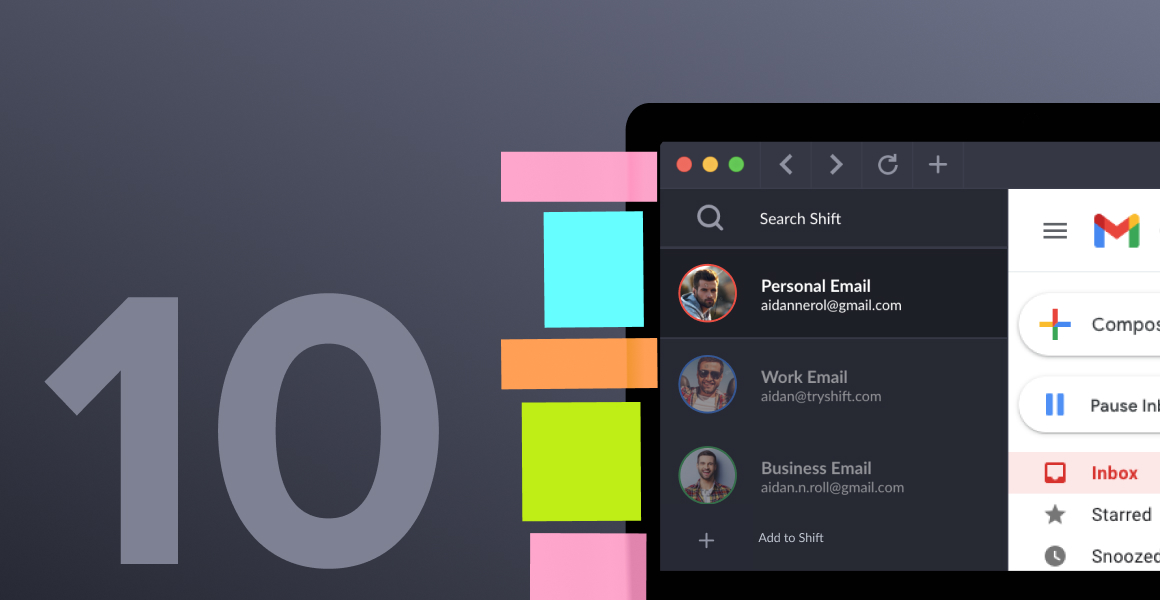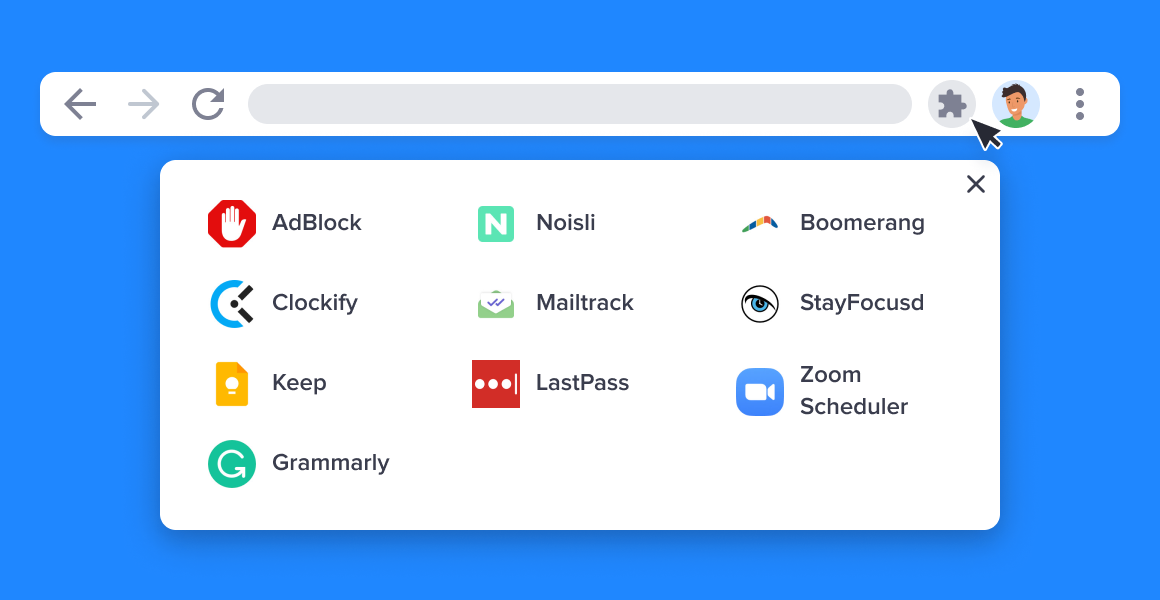The internet is an important part of daily life for most people. In fact, research shows that the average person spends more than 6 hours per day online. With that much of our lives devoted to a screen, it only makes sense to look for ways to streamline and simplify the things we do.
How you interact with your browser can make a significant impact on your life. In this article, we are breaking down 10 of our favorite hacks for improving browser functionality. Try these tips to make the most of the time you spend online.
Real Browser Hacks that Improve Productivity
1. Tab organization
You can try an extension to manage and declutter your open tabs, making it simpler to find what you need and reduce memory usage. Explore options like Tab Wrangler or OneTab to make the best use of your tabs. You can also group tabs in several different browsers, which can save time in your searching. One of the best ways to organize your online activity is by using Shift. With Shift, you can organize your tabs by account, and the way you work. Users can organize and streamline tabs by account or project, which allows for keeping context as well as limiting distractions. Designed for efficiency and focus, the functionality lets you easily store tabs and bookmarks in Workspaces. With the innovative Workspaces feature, you can keep important tabs on hand and organized, and then bookmark them for later on. The best part is that you won’t need to constantly log in or out of various accounts - everything is already organized according to how you use it, so you can skip the constant log-in and log-out process.
Related Article: Too Many Tabs Open? Try These Browser Management Tips
2. Bookmark organization
Folders and subfolders are an important part of working within your browser efficiently. By saving a website’s URL address for future use, you can save time and keep frequently visited websites handy. Bookmarking is especially helpful for websites with long or hard to remember URL addresses. Additionally, bookmarks are great for visiting a page that you view often, that happens to be buried within a few clicks of a website. For example, if you go to a specific client page that is a few clicks off of the home page, you may want to just bookmark that page instead of going to the home page and then drilling down. Plus, bookmarks are a great alternative to just keeping more tabs open. Many people don’t want to lose track of something they are working on, or visit often. Creating a bookmark instead of keeping the tab open allows you to revisit quickly and with little searching.
3. Search within a web page
Most of today’s well-designed websites are focused on user experience, and created with the understanding that people scan instead of read. Many people visit a web page looking for a particular piece of information, or answer to a question. If you are looking for something specific on a website, you don’t need to scroll through endless pages and click around on different menu items. You can find something specific by using Ctrl/Cmd + F as a shortcut. Doing so will allow you to quickly search for words or phrases and then go directly to the content where such terms are found. This can be a huge time saver when researching or trying to find information that you know you’ve seen before.
4. Use autofill on forms
Auto-fill functionality is a double-edged sword. There are several time-saving benefits, but a few caveats as well. Generally speaking, auto-fill saves time by automatically filling in repetitive information, such as your name, contact information, address, etc. It eliminates the need to manually enter the same type of information over and over again. Most people find it very convenient and easy to use, especially when filling out multiple forms or making online purchases. With just a few keystrokes, form fields can be populated with (correct) stored information. It’s also handy for ensuring accuracy. Using auto-fill reduces the chances of errors or typos that tend to occur when manually inputting information. Since it pulls the data from sources that have already been verified, the risk of mistakes is lowered. Similarly, you can count on a bit of extra security since many auto-fill features are built into password managers, which provide secure storage and encryption for sensitive information. In this way, your data has an extra layer of protection against being stolen or misused. That being said, before relying too heavily on it, you’ll want to make sure that your auto-fill information is correct and current. There may be instances where there are multiple saved entries for the same field - make sure to review before hitting submit on anything. Additionally, there is always a slight security threat when storing personal information like credit card details. It’s essential to use strong passwords and secure devices to lower these risks. Another consideration is compatibility. Some functionality may not work as well on all websites or forms. Occasionally there are incompatible coding or security measures in place that can prevent an auto-fill from working correctly.
5. Reader mode
This mode, also sometimes called reading view or reader view, is a helpful feature that is available in most web browsers. It aims to improve the reading experience by taking away distractions and presenting the online content in a cleaner, easier-to-read format. There are lots of good reasons for using reader mode when reviewing online content, including: improved readability, reduced eye strain, enhanced accessibility, and faster page load times. Reader mode works by removing ads, sidebars, navigation menus, and other things that might be considered clutter and otherwise slow the page’s performance down. Typically, reader mode presents the text in a larger font with more optimized spacing and stronger contrast, designed to make things easier to see. This distraction-reducing format is also good for limiting eye strain and the sort of fatigue that can occur when reading lengthy content or pages with excessive visual elements. Importantly, reader mode can also make web content more accessible to individuals with visual impairments or reading challenges. The stripped-down layout and customizable text settings often improve legibility and help to accommodate diverse needs. Finally, reader mode removes unnecessary elements, which can significantly improve page loading times. This is especially helpful on sites with heavy advertising or complicated layouts. It’s definitely worth trying if you are working with a slower internet connection or limited data plan - it can help you to make the most of what you’re working with. Many people also like to employ reader mode for offline reading. Some (not all) reader modes allow users to save articles or pages for reading at another time. They can download the content and store it locally on their device, so that they can read it later without having to rely on the internet. This is a great tip for long car rides or before boarding a plane.
6. Pin tabs
When you want to make the most of your space, but need to keep something available, then pinning a tab is the answer. To pin a tab is to minimize or shrink it down to a smaller size and then place it in a fixed position on your web browser’s tab bar. This means that it remains open and accessible, but takes up less space. Additionally, the pinned tab will be visually distinct from the other, regular tabs. It’s very helpful for saving space, getting quick access to something, and preventing accidental closing of tabs you need. You can also pin tabs to prioritize websites over others. For example, you might pin tabs that you need to be open at all times, such as a messaging app or productivity tool. This will keep them open and available even if you close all the other tabs on your desktop. This is also a powerful way to declutter your tab bar and keep things organized. You can save a lot of time by having a streamlined view of your tab activity and a faster way of navigating through them. This is a great hack for not only saving time and being more productive on web-based tasks, but decluttering and keeping your work space simple and straightforward.
Related Article: How to Manage Multiple Tabs in Chrome
7. Private (or incognito) mode
Incognito and private mode are essentially the same thing. It’s a feature available in most modern web browsers and it allows people to browse the internet without leaving a trace of their online activities on a device. What does that really mean? When browsing in private mode, the browser does not save things like browsing history, cookies, or site data. This helps maintain privacy and means that others who use the device will not have access to your used information. Additionally, private mode offers limited tracking by websites and other online services. When using it to browse, the browser will block third-party cookies and disable extensions that might be tracking your online behavior. However, that doesn’t mean that you should expect complete anonymity or protection against all forms of tracking. One of the best ways to use private mode is to have multiple windows open - one in normal mode and one using incognito mode for more private dealings. This can be really helpful for separating personal and professional activities, for example.
8. Keyboard shortcuts
There are a lot of common keyboard shortcuts that can be learned and utilized to perform functions. You can open a new tab (Ctrl + T) or reopen a closed tab (Ctrl + Shift + T), along with using the other shortcuts that you may use for general typing, etc. Using these shortcuts can significantly speed up your browsing experience, and they are likely to become a habit once you’ve used them a few times. Here are 15 of the most useful keyboard shortcuts for your browser:
-
- Ctrl/Cmd + T = Open a new tab
- Ctrl/Cmd + W = Close the current tab
- Ctrl/Cmd + Shift + T = Reopen the most recently closed tab
- Ctrl/Cmd + Tab = Switch to the next open tab
- Ctrl/Cmd + Shift + Tab = Switch to the previous open tab
- Ctrl/Cmd + L = Highlight the URL/address bar
- Ctrl/Cmd + D = Bookmark the current page
- Ctrl/Cmd + F = Open the find/search bar to search within a web page
- Ctrl/Cmd + (+/-) = Zoom in or out on a page
- Ctrl/Cmd + 0 = Reset the zoom level to default
- Ctrl/Cmd + R = Refresh or reload the current page
- Ctrl/Cmd + Shift + R = Refresh or reload the current page while bypassing the cache
- Ctrl/Cmd + Shift + N = Open a new incognito or private browsing window
- Ctrl/Cmd + Shift + B = Show or hide the bookmarks bar
- Ctrl/Cmd + Shift + Delete = Open the “Clear browsing data” menu
9. Get faster downloads
Who doesn’t want to download things at a faster rate? One of the best ways to manage that is with a download manager extension. This add-on enhances functionality of your web browser’s built-in download manager. That means it provides extra features and options that allow you to manage and organize your downloaded files. For example:
- Enhanced download management - You can pause, resume, and prioritize downloads which is especially helpful for large files
- Accelerated downloads - Some extensions use multi-threading or other techniques to speed up download speed
- Download organization - Use this to categorize and sort your downloads into different folders or directories which is helpful for finding materials later on
- Integration with cloud storage - Many download manager extensions support integration with common cloud storage solutions like Google Drive or Dropbox
- Download history and data - Use this to get a detailed view of download history, including information like date, time, and source for each
- Batch downloads - With batch downloading, you can select multiple files or links to download at a single time
- Virus scanning - Some extensions offer antivirus or malware scanning capabilities that automatically scan materials for potential threads
10. Customize your browser
There are plenty of extensions available for various web browsers that can enhance your browsing experience. Here are some of the more popular options to consider:
-
- Adblock Plus - Blocks intrusive ads on websites, improves page loading speed, and provides a cleaner browsing experience.
- LastPass - Securely stores and manages all of your passwords, which makes it easier to log in and out and manage online security (Hint: For even better management of logging in and out, make sure to download Shift. Keep reading!).
- Dark Reader - Use this to enable dark mode for websites which makes things easier on your eyes and saves power on OLED screens.
- Grammarly - Checks spelling and grammar in real-time while you type, ensuring error-free documents and communications.
- Pocket - Save articles, videos, and other web content to read things or view them later when you’re offline
- Enhancer (for YouTube) - Adds various features to enhance your YouTube experience, with ad-blocking, video playback speed control, dark mode, and more.
Related Article: The 10 Best Browser Extensions for Productivity
Streamline Browsing With Shift
One of the best things you can do to improve your browser productivity is to implement Shift.
Shift is an innovative platform that can be used for a better, faster web browsing experience. One of users’ favorite features is the ability to work within focused web tabs. By accessing the web from inside Shift, you can manage your tabs and organize them for a better browsing experience. People love the ability to streamline tabs in the way that works for them - for example by account or project. They can keep context, avoid distraction, and increase overall efficiency.
Additionally, you can easily access and store tabs and bookmarks in Workspaces. This makes it simple to have important tabs on-hand and organized by workspace, then bookmark them for quick access later on. You can even add your favorite extensions and make sure they are set up with the programs you use most in your browser. Leveraging Workspaces is a great way to cut down the logging in and out process that can be so cumbersome.
Anyone who uses online platforms will find Shift to be a powerful resource. With Shift, you can organize and manage the following:
- Mail - Connect all of your Gmail, Outlook, and Office 365 accounts and manage everything from one centralized workstation.
- Apps - WhatsApp, Slack, Messenger—we have everything you need to get it done. Browse our Apps Directory, connect yours, and switch between them easily.
- Search - Save time and find exactly what you're looking for across any of your Mail, Calendar, and Drive accounts.
- Chrome extensions - Enjoy access to Boomerang, Grammarly, LastPass, and many of your other favorite Chrome Extensions.
- Workspaces - Create a Workspace with the exact apps, tabs, and bookmarks you need, then share it with your team to get the job done.
- Account management - Toggle between your most-used accounts, check notifications and streamline your workflow.
If you’ve been spending a bit too much time in your web browser lately, try some of these tips. You’ll find real value in streamlining your browser experience so that you can navigate the web and perform your tasks more quickly. We especially recommend limiting the amount of times that you log in or out of your various accounts - and downloading Shift is the fastest way to make that happen. A streamlined browser experience will make you more efficient, more productive - and less stressed.


















 Share on Facebook
Share on Facebook Share on Twitter
Share on Twitter







